- Fisher vs Trapper Stardew Valley - January 30, 2023
- Journey of the Prairie King Guide: Give Stardew Valley’s Arcade Game Some Hell - January 17, 2023
- Botanist or Tracker Stardew Valley: The Best Foraging Profession - January 14, 2023
Stardew Valley can be without an introduction. But if you’re part of an alien species who just arrived on earth, it’s a video game about managing your resources daily, season by season, year by year. During each stage, we will strengthen our ties with the townspeople, improve our crops, and discover mysteries. But, of course, we’ll first need to learn how skills work in the game to get there.
In essence, there are five types of Stardew Valley skills: Agriculture, Mining, Foraging, Fishing, and Combat. Of course, you can develop some of them. In fact, the game doesn’t require you to follow any specific path. But in case you want to make the most of it and see its ending through, you’ll want to master them.
Most of them are intrinsically complex.
Let’s think about mining, which has infinite levels and difficult enemies to fight against. And fishing? Whether you fish at night, during the day, in the rain, or in sunny weather. Don’t even get me started on farming. Farming, as expected from a farming game, is a next-level difficulty.
But today, we’ll focus on foraging. Yes, the one about simply picking stuff up from the ground. In this guide, we’ll cover which Foraging profession is the best and which one is for you: Botanist or Tracker?
Bottom Line UpFront:
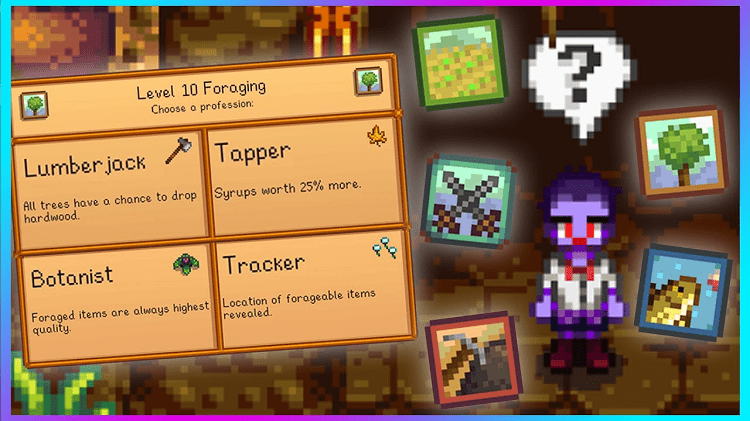
This guide has been hand-crafted to cover all the Foraging related aspects: leveling up to 10, foraging the best items, getting the best quality items- all leading up to the final decision: Should I become a Botanist or a Tracker? Still, you’ve got a split screen with two options right in front of you, and you’d like to decide quickly. Here is a too-long; didn’t read version of this guide:
Botanist
This profession is ideal for money-makers. If you’re interested in making some coin, this profession is for you. Make sure every item you grab is only of the best quality with your botany skills.
Tracker
Are you a completionist? Are you on your way to completing the Museum or getting some specific item? Well, you’ve found your call. Track it all down.
Forager Overview
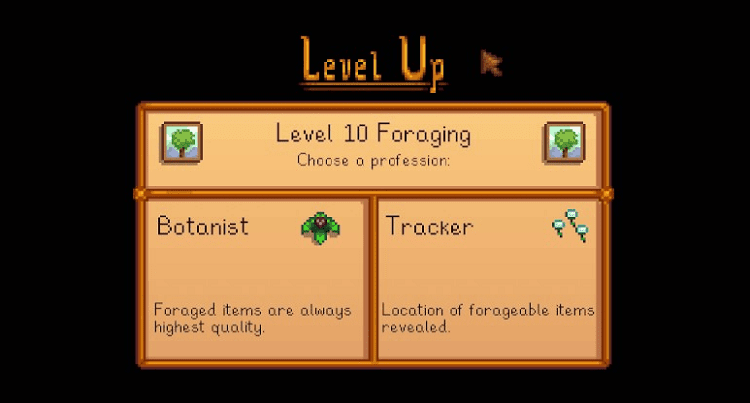
Foraging is about picking stuff up off the ground. That’s how it works. Whatever you pick from the ground is considered a forageable good. This is because it gives you a foraging experience. The more you level it up, the better it gets and the more reward it gives you.
It’s the skill that people often level up soon because they tend to pick up a lot of stuff as they’re running around in the early game. It’s the best thing to do. It gives you a lot of energy, a lot of experience, and a money-making machine when done right.
How Foraging Works
Now when you start a new game, there will be forageable goods spawned all over the world. You can run around and pick them up. They spawn in pretty much every area in the game.
Foraging goods all act similarly: they change throughout the seasons. After picking all the forgeable items on the map, it’s important to note that you’ll get two to five new ones appearing for every area daily. Now, what constitutes an area, you might ask? It’s anywhere with a transition screen.
The Untold Benefits of Foraging
Every time you level up your forging skill, you will increase your axe proficiency by just a little. So by the time you’re all the way to level 10, you use one less energy to swing your axe. Instead of using two energy, you need one.
Making Profit Out of Foraging
The forageable goods can be worth a lot of money. For example, if you find the mushroom floor down in the mines, you can get a whole bunch of mushrooms here in a single day. Several hundred of them. They’re all very valuable, too.
FYI: The mushroom floor spawns in the mines. It goes between floors 80 and 120. You can find it randomly every day
Level 5 Forager: First Choice
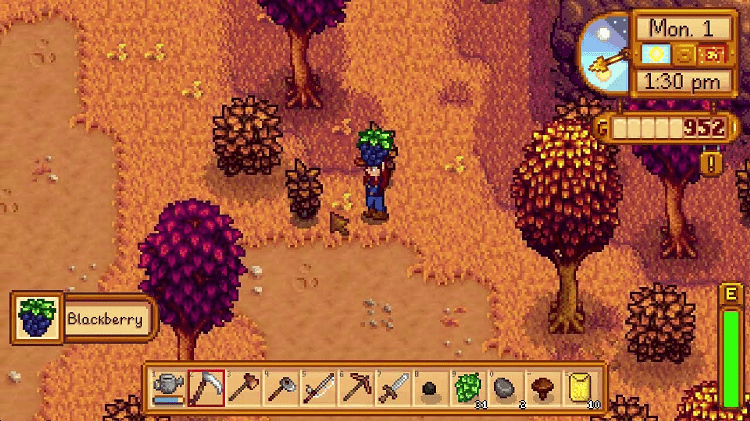
The first career choice comes at level 5, you can either become a forester or a gatherer.
Forester gets 25% more wood from chopping trees. Gatherer gets double items every item you forage. If you’re here, you likely chose Gatherer. As you should have. Double harvest of foraged items, baby! Why wouldn’t you want that?
Still, you might consider taking a completely different path if you want to make new buildings for your farm.
Foraging Your Way to Level 10
The real choice comes at level 10: Do you Want to be a Botanist or a Tracker?
Botanist or Tracker, Which One is Better?
At Foraging level 10, we’re left with another choice. We can choose between the Botanist, which means foraged items are always your highest quality, or Tracker, which means the map marks forageable goods.
Before making our choices, let’s have a look at each.
The Botanist: Quality over Quantity
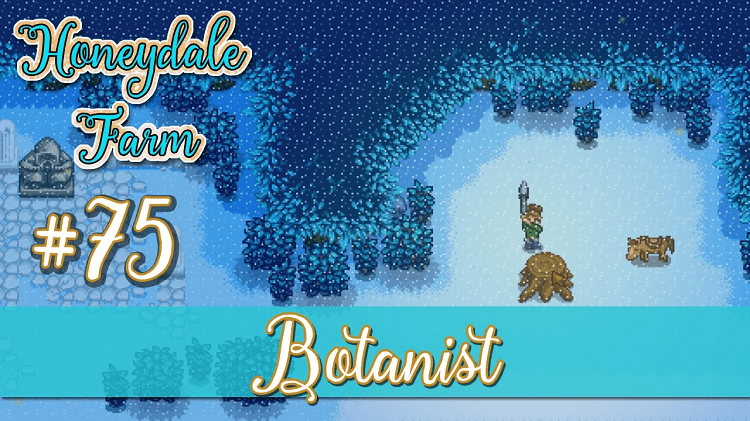
As a Botanist, you’ll get the essential quality over quantity skill. Then, when you find something to forage, the item will be of iridium quality.
Pros:
- Higher Profit
Everything being Iridium-level quality means you’ll make a higher profit from selling items.
- Better Gifts to NPCs
When you gift high-quality items to NPCs, it increases your heart gauge much faster.
- Saving Space
Yes, you read that right. Items of the same quality stack. Everything you pick up is Iridum-quality, so you won’t waste inventory space.
Cons:
- Time-consuming
The alternative does show everything on the map. But, as a Botanist, you’ll continue to blind search for items. So, finding goods is still time-consuming.
- High Quality… Garbage?
Some items, though high-quality, have little value. You’ll sometimes come across an item that will give you little profit, regardless of the quality.
How to Make the Most Out of Botanist
Stardew Valley players love to think of animals as a lousy investment. You have to put down a bunch of cash up front, but you’ll slowly see the returns build up over the weeks.
To start your money-making machine, you’ll need the following
- Luxury Barn: 20000g
- Pig: 16000g each
If I put it like that, it does sound like a waste of money, right?
How about this:
Pigs give you truffles, sold at 625g, and increase to 1250g if they are high quality.
Aren’t you glad you picked the Botanist profession?
FYI: Truffles can be converted into truffle oil which sells for 1065g and increases to 1491g if you are a craftsman. In the oil mill, truffles take 6 hours of the game (6 real-life minutes) to become oil.
You can quickly get 10 truffles per day that can be converted into oil and sold for 14910g, so you can earn 14910g and much more per day.
This whole pig farming business does have a downside: In winter, the pigs stay in the barns. So you’ll have to cook up a new strategy for this season.
The Tracker: Quantity over Quality
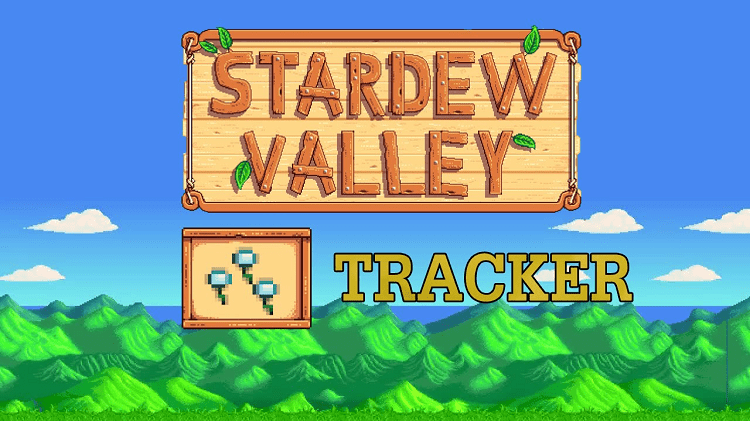
If you choose Tracker, arrows point up the forageable item’s location on the map. An arrow will appear on your screen’s edge and point toward worm spots in your area. If you walk into an area and notice the arrow is missing, there simply isn’t anything to forage.
This is extremely useful to ensure you find all daily forageable per area before the day ends.
Pros:
- Time saver:
You spend less time looking for things. They are right there on your map.
Say goodbye to the days in which you spent time looking for things in an area where there was nothing at all. With Tracker, you’ll walk into the area and know if what you are looking for is here and even get specific directions as to where you can find it.
- Ideal for the collectionist
This job is for you if you’re looking for something specific or completing the Museum. If you aren’t looking to make cash and just want to complete quests in the game, Tracker is for you.
Cons:
- Make Room, Everyone
If you’re going for the tracker profession, you better start planning for an inventory expansion. You’ll be picking up items of different qualities which don’t stack up like the Botanist.
- A Profitless Craft
Unless you make a point of searching for profitable items – which aren’t usually at the touch of your fingertips- you simply won’t be making that much profit with Tracker.
- A Limited Buff
At first, it seems like your map is getting a UI buff. Now, there’s arows pointing to the right place to go.
However, the arrows only point to the worm tiles. It won’t show collectables on bushes, like salmonberries, or on crops, like the spring onions.
How to Make the Most out of Tracker
There’s no point in lying: you won’t make money out of Tracker.
But that doesn’t mean there is no profit.
Completing the Museum
The Museum is one of the collectible side activities (or main activity, depending on how seriously you take your collectibles) in the game. First, you’ll have to restore the old Museum by donating a series of items.
To complete a task like this, a map showing each item’s location can come in handy.
Finding the Lucky Ring
The Lucky Ring is an item that provides Luck+1. Luck is a factor that plays a massive role in how the events in Stardew Valley unfold daily.
One way to quickly find this ring is to have a professional who will tell you where it is. Take full advantage of the Tracker profession to figure out which lake, river, or pond you need to pan for your Lucky Ring.
Getting all the Achievements
Some achievements, like Full Shipment, which requires you to ship every item in the game, or Mystery Of The Stardrops, which requires you to find every Stardrop, will be easier with the Tracker skill.
Those blue arrows in the map indicating where the forageable goods are will come in handy if you’re looking to get the game to 100%.
So, Which One Should I Pick?
This one’s up to you. If you want to find more forwardable items at this point, great. Generally, by the time you’re level 10, you don’t really need to find much stuff. That’s why I always choose Botanist. That way, when you find what you’re looking for, your items will always be Iridium quality.
Those truffles you pick up from the pigs? Always Iridium. And very, very valuable. They definitely make having pigs worth it. Same with everything else you pick up. And, Iridium quality means more health and more value. High-quality forgeable items can make for good gifts, too. Obviously, the higher the quality, the more people like them.
Unless they’re poisonous mushrooms that Linus doesn’t want to eat.
FAQs
Question: When do you unlock the Botanist and Tracker professions in Stardew Valley?
Answer: It will take lots of bending over to pick up items before you unlock these professions. However, you’ll unlock the choice to become either a Botanist or a Tracker once you get your Foraging skill up to 10.
Question: Can you switch professions in Stardew Valley?
Answer: You may want to find something particular with Tracker before becoming a full-time Botanist. That’s perfectly understandable. You can switch professions by giving 10,000g to the Statue of Uncertainty in the Sewers.
Question: How to Unlock The Sewers?
Answer: The previous answer was only constructive if you unlocked the Sewers.
To unlock the Sewers, you’ll need to get the Rusty Key. Gunther will give you the Rusty Key when you complete the Museum. Yes, becoming a Tracker to complete the Museum, unlocking the Ruster Key, and then coming to the Sewers to switch to Botanist is the dream journey.
Botanist or Tracker Stardew Valley: Parting Words
Choices are never easy. But it always helps to know your options. Either way, the foraging skill is one of the most accessible in the early and rewarding in the late game. This skill can get you all the energy and coin you need for your playthrough.
I’m sure you’ll find some use in whatever path you choose. Stardew Valley offers a myriad of ways to play the game, but none of your choices will hinder your progress. No, it’s not ‘just another’ farm management game. Instead, it’s a magnificent one that takes you to live in a rural society where there is also a place for adventure and even social awareness.
Make the most of your foraging experience and become the expert you’ve always dreamed of.

